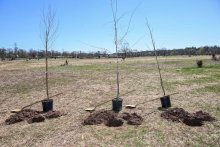Ceremony Marks Launch of New Jersey Floodplain Reforestation Project
April 17, 2025
On Wednesday, April 9, 2025, a groundbreaking event took place for the Raritan River Floodplain Reforestation Project in central New Jersey. This project will create 112 acres of forested floodplains and wetlands at property owned and managed by the Duke Farms Foundation adjacent to the Raritan River–approximately 2.8 miles upstream of the American Cyanamid Superfund Site.
Trustee partners were on site to officially kick off the restoration work that began in March. Along with our U.S. Fish and Wildlife Service and New Jersey Department of Environmental Protection colleagues, NOAA will oversee the progress of the plantings and review monitoring reports to verify the project has met performance goals on a yearly basis. The first inspection was conducted ahead of the groundbreaking. NOAA made an inspection of the 19,000 nursery plants delivered to the site. An additional 30,000 trees and shrubs will make their way to the planting site over the course of the next year.
The restoration project is designed to compensate the public for potential injuries to floodplains and wetlands resulting from releases of hazardous substances at the American Cyanamid Superfund Site. The Raritan River Floodplain Reforestation Project is separate and distinct from the cleanup of the Superfund Site.
The Raritan River Floodplain Reforestation Project will:
- Support fish migration and amphibians by enhancing habitat
- Provide flood protection
- Protect the adjacent river
- Improve air and water quality
- Increase access to nature including birding and hiking for local communities
These expected outcomes are part of a collaborative, watershed-wide commitment to healing this historic river. It is a testament to what can be achieved when industry, government, and the local community work together. The project is expected to take five years to complete with an additional 10 years of maintenance and monitoring that will ensure the success of the project. Survival and growth of the plantings, coverage by native vegetation, and hydrology of ephemeral pools are among the metrics that will be tracked.
The third settlement of natural resource injuries at the American Cyanamid Superfund Site was finalized in April of 2024 with a potentially responsible party, Wyeth Holdings LLC. For decades, the American Cyanamid facility was the site of multiple hazardous substance releases, including a range of contaminants that were discharged directly into the Raritan River. The factory manufactured chemicals and pharmaceuticals, and distilled coal tar. Cuckolds Brook, which crosses the site and flows into the Raritan River, was a conduit for untreated liquid waste from the early 1900s through the 1930s. A dispersant weir–a perforated pipe embedded within a concrete dam to distribute the release of contaminated water along the width of the river–was constructed adjacent to the facility in the Raritan River in the late 1930s to increase the mixing of untreated effluent into the river.
View the project one-pager and event poster that were available at the event.
For more information and to stay in the know, sign up for DARRP’s Coastal Recovery news.







